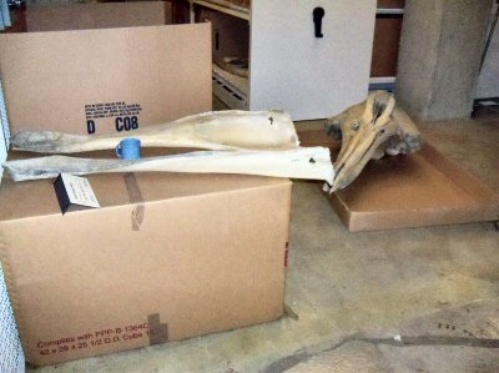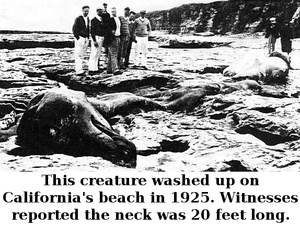Bobo There were stories of a sea creature off Cape San Martin near the Big Sur area. This creature acquired the name Bobo. (A Spanish word synonymous with "stupid.") Later, sightings of a sea creature in Monterey Bay moved the legend of Bobo to Monterey Bay. While descriptions varied, there was enough similarities to suggest Bobo was an elephant seal. At least one book and several oral traditions claim the sightings were from the 1920's to the 1940's. "The Legend of Bobo" is a movie made in 2007 by Bella Media, Inc., and is based upon this legend. In the book, "Mysterious Sea Monsters of California's Central Coast" the author, Randall Reinstedt, suggests some of the sightings were of a different sea creature.
 |
This article is in need of a Photo.To add an image to this page, click "Edit" then click the image button. |
Moore Beach Monster
(Moore Beach is now called Natural Bridges State Beach)  Photo of the skull in background, the lower jawbones in foreground. The blue cup is 3.75 inches high for scale. Photo through special consideration of the California Academy of Science.
Photo of the skull in background, the lower jawbones in foreground. The blue cup is 3.75 inches high for scale. Photo through special consideration of the California Academy of Science.
The following is from the Journal of Mammalogy, November 1929, an article by M. E. MCLELLAN DAVIDSON ,California Academy of Sciences, San Francisco, California.
" On June 4, 1925, the newspapers of Santa Cruz and San Francisco, California, apprised the public of the occurrence of a sea serpent, or other more or less fabled marine monster in California waters. A few days prior to the newspaper stories, the remains of a large marine animal had been washed ashore on the beach at Santa Cruz, California. Decomposition had set in, and close examination of the carcass was not lightly undertaken. Consequently, the tales were the result of distant and hasty examination. When the news of the presence of this creature reached Dr. Barton Warren Evermann, of the California Academy of Sciences, he visited the spot and pronounced the "sea serpent" to be the eviscerated carcass of a beaked whale. More specific identification was impossible at that time, but arrangements were made to have the skull preserved and it is now incorporated in the collections of the California Academy of Sciences.
Examination of the skull after its arrival at the museum proved it to be that of the rare Baird's beaked whale (Berardius bairdii Stejneger), previously known to science by only ten specimens. [The article continues with a listing of previously found specimens and the measurements of the skull.]
When the skull reached the museum, the tips of the mandibles had been broken off, and one pterygoid and the teeth were missing; otherwise it was in good condition."
Adding to the story in books and articles is the account that E. L. Wallace, believed the creature was likely "a variety of plesiosaur." The plesiosaur, was a marine reptile common from the end of the Triassic period until the end of the Cretaceous period. It has been extinct for 65,000,000 years. The plesiosaur was a marine reptile and the "Moore Beach Monster" was a marine mammal. Artist rendering of a Beaked Whale. Note the lack of detail in the forward fin.
Artist rendering of a Beaked Whale. Note the lack of detail in the forward fin.
E. L. Wallace is referred to as "renowned naturalist," "a man who served twice as president of the Natural History Society of British Columbia," and "president of the Natural History Society of British Columbia." Who he was, remains a mystery. The Natural History Society of British Columbia existed from 1890 to about 1904 and there are few records about it. No writings mentioning E. L. Wallace outside of the 1925 interview have been found. He published no books, no articles in any surviving journals, and is not listed in any index of that time.
A few sources have speculated that the beach was named for Charles Moore who reported the carcass. This is untrue. The beach had been known as Moore Beach since the 1890's. It was named Moore Beach because Moore Creek enters the sea at that area. Moore Creek was named for Eli Moore. (The creek went though his property.)
One of the problems of identification is the teeth are missing. Sadly, collecting teeth of marine creatures was popular. This would also explain why the beak was broken at the tip. The skull is still at the California Academy of Science in San Francisco.
Sharon Novak and the Sea Creature
Animal Planet had a series called "Lost Tapes." Episode 3 of season one, first aired in January 2009, tells about Sharon Novak and a sea creature. The film credits Lauren Olipra as the actress playing Sharon Novak. Allegedly, on July 17, 2007, while attempting a round-the-world trip, in her sailboat named Artemis, journalist Sharon Novak got a distress call while in Monterey Bay. When she arrived at the scene she found an empty boat. Her boat got bumped and she fell over board. While trying to swim back to the boat, she was eaten by a sea creature.
A camera atop the main sail mast records her efforts to get back to her boat. A waterproof camera she was wearing records a fin and some splashing. This supposedly happened in summer of 2007. A few problems that people have noticed. No news stories on Sharon Novak and no story of a lone woman boat owner going missing in Monterey Bay have been found. No one in Monterey or Santa Cruz has a record of such an incident. The Coast Guard in Monterey, California has no record of any incident involving a vessel named Artemis or any record of Sharon Novak in all of 2007. How is it her waterproof camera survives and her body does not? No writings or blog of Sharon Novak have been found. A search for Sharon Novak on the internet, finds a few discussions about why people believe the story is a hoax.
A 42-foot sailboat named “Artemis” does exist. It is owned by, Great Traditions Of The Sea, in Malibu, California. It is for teaching sailing and is otherwise for rent.
Diablo Rojo
In 2007 the Humboldt squid, also known as the giant squid or jumbo squid, was appearing off the California coast and were reported in the Monterey Bay by summer. Normally these squid live in warm waters off South America and Mexico, where fishermen call it "diablo rojo" (Red Devil). Fisherman were concerned because the creatures were about seven feet long and were known for eating lots of fish. These squid travel in large groups. Newspapers had fun calling the squid, monsters. The Sydney Morning Herald (Australia) called the squid, "A mysterious sea creature, more than 2 metres long, weighing up to 45 kg. It hunts in packs of hundreds, flying through the water at 40 kilometres an hour, changing colour." Some articles even speculated on how to cook an 88 pound (giant) calamari.
Links:
- : California Academy of Science website.
- :Catalog of the remains at California Academy of Science Mammalogy Collection Database"
- :Details of the skull story.
- :Bobo story.
- :Beached Monster article.
- :IMAX film discription on Bobo.
- :information on plesiosaurs.
- :Sydney Morning Herald squid article.
Related Links
Comments
2011-01-16 16:16:16 Sharon Novak is only a character from the lost tapes. The lost tapes is merely putting sightings into a story about what if the legends of sightings of these creatures are true. I like the show myself and does make you wonder if the sightings are true not the show. I believe if you don't see it don't mean it don't exist. —70.137.0.42
2012-02-12 02:12:02 The format of the show does lead some to believe the show is re-telling a story. The show promotes itself as mystery, paranormal, and not as fiction. In 2009, "Lost Tapes" included the 1925 photos in a episode "Monster of Monterey" with the suggestion that "it might have been a plesiosaur."


